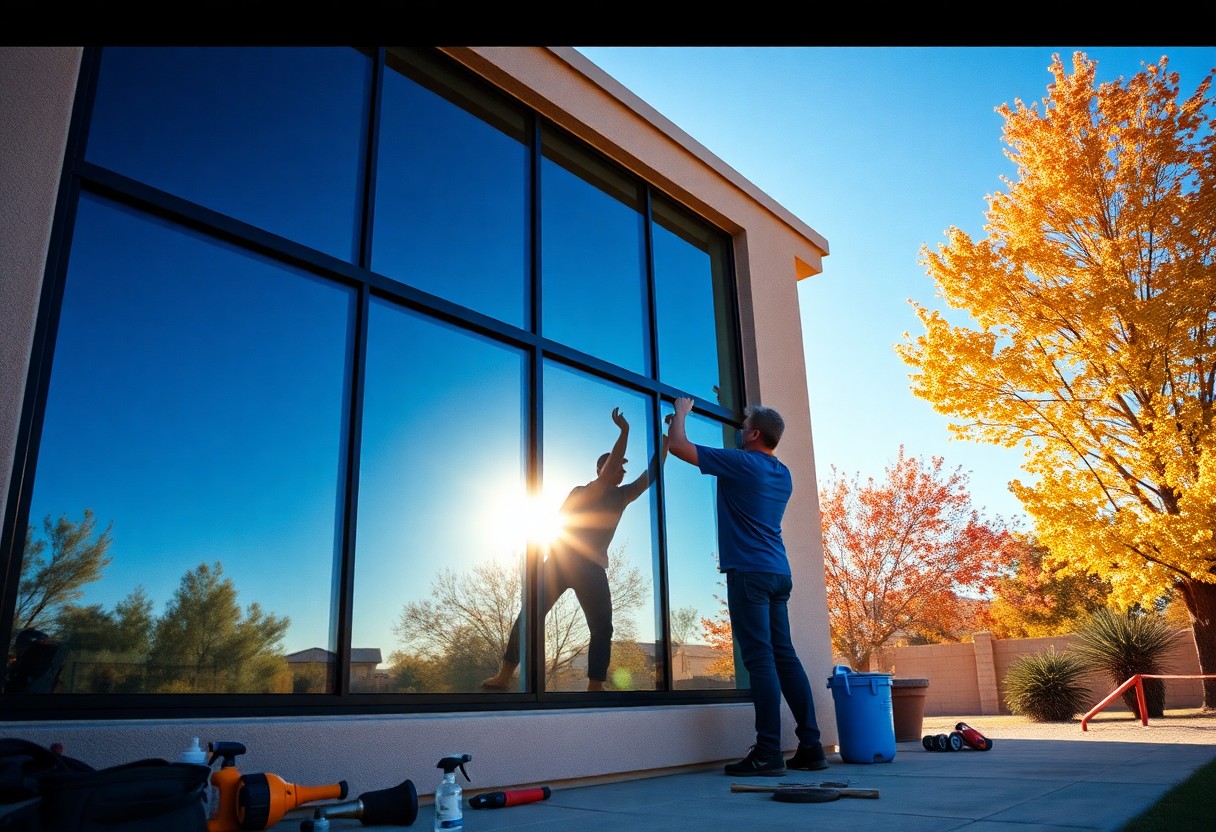You want your windows to look great and perform well year-round, especially in the unique climates of El Mirage and Anthem. Regular maintenance, including proper window tinting and washing, not only enhances the aesthetics of your home but also improves energy efficiency and protects your interiors from UV damage. This guide offers practical tips to help you maintain your windows’ appearance and functionality through each season. Follow these steps to ensure your windows remain a valuable asset to your property.
Understanding Window Tinting
Window tinting enhances your vehicle or home’s glass surfaces, offering various benefits such as improved aesthetics, heat reduction, and increased privacy. Knowing the specifics can help you make informed choices about your window tinting options that suit your needs.
Benefits of Window Tinting
Window tinting provides numerous advantages, including UV ray protection, reduced glare, and temperature control. It also protects your interior from fading and enhances privacy without sacrificing natural light.
Types of Window Tinting Films
There are several types of window tinting films available, each offering unique features and benefits. Common options include dyed, metallic, ceramic, and hybrid films, allowing you to choose based on your specific needs, such as durability and heat rejection.
| Type of Film | Description |
| Dyed Film | Affordable with basic UV protection. |
| Metallic Film | Includes metal particles for better heat rejection. |
| Ceramic Film | Non-conductive with superior heat rejection and clarity. |
| Hybrid Film | Combines dyed and metallic elements for balance. |
| Privacy Film | Designed for enhanced privacy without compromising visibility. |
Choosing the right type of window tinting film depends on what you prioritize in terms of performance and appearance. Dyed films are cost-effective but provide minimal heat reduction, whereas ceramic films offer optimum protection from UV rays and high durability. Hybrid films blend the benefits of both variants, making them a versatile choice. You should weigh these options to find the best fit for your requirements.
- Dyed films minimize glare but can fade over time.
- Metallic films offer a sleek look and better heat reduction but can interfere with electronic signals.
- Ceramic films exclude up to 99% of UV rays while maintaining visibility.
- Hybrid films provide a balance between cost and performance.
- Any choice depends on your specific needs and preferences.
| Feature | Dyed Film |
| UV Protection | Moderate |
| Heat Rejection | Basic |
| Appearance | Dark |
| Durability | Lower |
| Cost | Low |
- Consider how much light blockage you need.
- Evaluate the film’s warranty for longevity.
- Be aware of local laws and regulations on tinting.
- Research products for ease of installation if doing it yourself.
- Any additional features may enhance your experience.

Seasonal Effects on Window Tint
Different seasons significantly impact the performance and longevity of window tint. During winter, colder temperatures can affect the adhesion of the film, while summer heat can accelerate fading and deterioration. Regular maintenance specific to each season ensures your tint remains effective and visually appealing, enhancing your vehicle’s comfort and aesthetic appeal.
Winter Considerations
In winter, the extreme cold can lead to issues with window tint adhesion. It’s advisable to avoid putting your vehicle through car washes with harsh chemicals that can further compromise the film. Keep your windows clean using gentle solutions and a soft cloth to prevent scratching and peeling.
Summer Heat
High summer temperatures can cause window tint to bubble or peel if it’s of inferior quality. Protect your windows by using sunshades, parking in shaded areas, and applying high-quality ceramic tints that resist UV rays. Investing in proper tint not only blocks heat but can significantly reduce glare, improving your driving comfort during peak sun hours.
The impact of summer heat on window tinting is substantial; prolonged exposure to intense sunlight can break down the film’s adhesive, leading to unsightly imperfections. Choosing window films with a higher heat tolerance rating means less risk of damage. Additionally, a good quality tint prevents up to 99% of harmful UV rays, which helps keep your vehicle’s interior cooler, thus enhancing both comfort and the lifespan of your upholstery and dashboard. Regularly inspecting your tint for signs of wear, such as bubbles or discoloration, allows you to address issues before they escalate, ensuring your tint continues to provide optimal protection against the summer heat.
Cleaning Techniques for Window Tint
Maintaining your window tint involves specific cleaning techniques to avoid damage and ensure clarity. Always start with a thorough inspection, looking for any visible defects or scratches. Use soft microfiber cloths to gently wipe the tinted surfaces, as harsher materials can scratch the film. Work from top to bottom, and consider using a squeegee for a streak-free finish. Regular cleaning not only enhances visibility but also extends the life of your tint.
Recommended Cleaning Products
Select gentle, ammonia-free cleaners specifically designed for window tint. Products like distilled water mixed with vinegar or specialized window tint cleaning solutions work well without causing harm. Always check the ingredient list before application to ensure compatibility with your tint film. Avoid using household cleaners containing bleach or strong solvents, as they can deteriorate the tint over time.
Safe Cleaning Methods
To effectively clean your tinted windows, prioritize safe methods that won’t compromise the film’s integrity. Use a soft microfiber cloth, dampened with your chosen cleaning solution, and avoid excessive pressure. Circular motions effectively lift dirt without risking scratches. After cleaning, ensure proper drying with another clean microfiber cloth to prevent water spots.
When applying cleaning methods, approach each window section with light pressure. This helps prevent abrasions while effectively removing debris and grime. If you’re dealing with particularly stubborn stains, allow the cleaner to sit briefly before wiping it away. Using a two-cloth method—one for applying cleaner and another for drying—can enhance results and protect the tint. Keeping the microfiber cloths clean and replacing them regularly further ensures optimal cleaning without risk of damage to your window tint.
Importance of Professional Maintenance
Professional maintenance ensures that your window tinting remains effective and visually appealing over time. Skilled technicians understand the nuances of tint materials and can perform necessary repairs or replacements, preserving both the aesthetics and functionality of your windows. Regular professional care protects your investment, prevents costly damage, and enhances the overall experience of driving in both El Mirage and Anthem.
When to Seek Professional Help
When you notice peeling, bubbling, or discoloration in your window tint, it’s time to seek professional help. Additionally, if your visibility is compromised due to accumulated grime or if your tint doesn’t provide the heat and UV protection it once did, consulting an expert can restore both the look and functionality of your windows. Regular evaluations, particularly before and after seasonal changes, can also guide you on the best timelines for professional intervention.
Finding Trusted Professionals in El Mirage and Anthem
Finding trusted professionals in El Mirage and Anthem involves searching for certified window tinting services with solid reputations. Look for businesses with customer reviews, and ask for recommendations from friends or local automotive shops. Comparing quotes and services offered can also help you identify the right fit for your maintenance needs.
You can easily enhance your search for trusted professionals by utilizing local online platforms such as Yelp or Google Reviews, where customer feedback can provide insights into service quality. Checking for affiliations with industry organizations can also indicate professionalism and adherence to standards. Don’t hesitate to request portfolios showcasing previous work; this can give you confidence in the expert’s capabilities. By doing your homework, you’ll ensure that your window tint receives the care it deserves.
DIY Maintenance Tips
Performing DIY maintenance on your window tint can help maintain its integrity and appearance. Here are some quick tips you can follow:
- Regularly clean your tinted windows with a soft cloth.
- Avoid ammonia-based cleaners that can damage the tint.
- Use a squeegee for a streak-free finish after washing.
- Inspect the edges of the tint for peeling or bubbling.
- Apply sunshades when parking for extended periods.
Knowing these simple practices can prolong the life of your window tint and enhance your vehicle’s aesthetics.
Regular Inspections
Conducting regular inspections of your window tint is necessary to catch any issues early. Check for bubbles, peeling edges, or discoloration at least once every few months. This proactive approach allows you to address minor problems before they escalate into costly repairs or require professional replacement.
Home Remedies for Minor Repairs
For minor repairs on your window tint, consider using basic items you likely have at home. A mixture of soap and water can help clean the surface and remove dirt without risking damage. In cases of small bubbles, gently pressing them out using a credit card can be effective. If the tint starts to peel at the edges, a small amount of adhesive can secure it temporarily until you can seek professional help.
Some common home remedies for window tint repairs include applying a mix of dish soap and water to smooth out small bubbles or wrinkles. For peeling edges, a glue stick can often provide an effective temporary fix. If the tint is lightly scratched, a mild rubbing compound can reduce visibility of the marks. These methods are simple yet practical, allowing you to extend the life of your tint until a professional can provide a more permanent solution.
The Role of Washing in Window Care
Washing your windows regularly is vital for preserving both the functionality and aesthetic of your window tint. Dirt, grime, and environmental pollutants can accumulate on your glass surfaces, compromising the tint’s effectiveness and clarity. By incorporating a consistent washing routine, you ensure that your windows remain clean, enhancing your home’s appearance and extending the lifespan of your window treatments.
Frequency of Washing
Aim to wash your windows at least twice a year, ideally in spring and fall. Seasonal washing helps prevent buildup from pollen, dust, and other contaminants. If you live in an area with heavy pollution or during dusty months, consider increasing the frequency to once every few months to maintain optimal clarity.
Best Practices for Washing Windows
When washing windows, use a soft cloth or sponge with a pH-neutral solution to avoid damaging the tint. Avoid abrasive materials and harsh chemicals that can scratch the surface. It’s best to wash on overcast days to prevent streaks caused by direct sunlight drying the solution too quickly.
For effective window washing, start by rinsing the glass to remove loose dirt. Then, apply the cleaning solution with a sponge, working from top to bottom in a circular motion. This method prevents dirty water from dripping down onto already cleaned areas. For tinted windows, consider using a dedicated automotive window cleaner that’s safe for tints, ensuring you preserve their integrity while achieving a clear finish.
Conclusion
Summing up, maintaining your window tinting and washing in El Mirage and Anthem is crucial for the longevity and performance of your vehicle. You should regularly assess your tint for damage and ensure it complies with local regulations. Additionally, a scheduled washing routine will keep your windows clear and enhance visibility. By following these seasonal maintenance tips, you can protect your investment and enjoy the benefits of clear and effective window tinting throughout the year.





